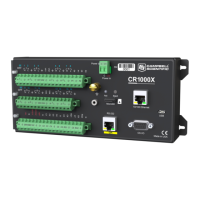abbreviation of the data process that outputs the data to storage. A list of these abbreviations
follows in Data processing abbreviations (p. 35).
If a field is an element of an array, the field name will be followed by a indices within parentheses
that identify the element in the array. For example, a variable named Values, which is declared
as a two-by-two array in the datalogger program, will be represented by four field names:
Values(1,1), Values(1,2), Values(2,1), and Values(2,2). There will be one
value in the second header row for each scalar value defined by the table.
If the default field names are not acceptable to the programmer, the FieldNames()
instruction can be used in the CRBasic program to customize the names. TIMESTAMP, RECORD,
BattV_Avg, PTemp_C_Avg, and Temp_C_Avg are the default field names in the previous
Example data (p. 33).
The third header row identifies engineering units for that field. These units are declared at the
beginning of a CRBasic program using the optional Units() declaration. In Short Cut, units are
chosen when sensors or measurements are added. Units are strictly for documentation. The
datalogger does not make use of declared units, nor does it check their accuracy.
The fourth header row reports abbreviations of the data process used to produce the field of
data.
Table 4-5: Data processing abbreviations
Data processing name Abbreviation
Totalize
Tot
Average
Avg
Maximum
Max
Minimum
Min
Sample at Max or Min
SMM
Standard Deviation
Std
Moment
MMT
Sample No abbreviation
Histogram1
Hst
Histogram4D
H4D
FFT
FFT
Covariance
Cov
Level Crossing
LCr
4. Data 35

